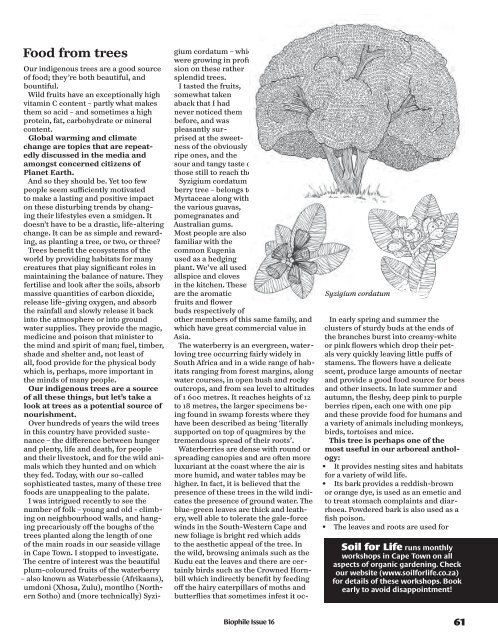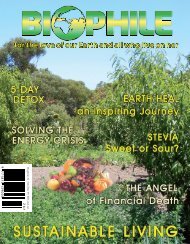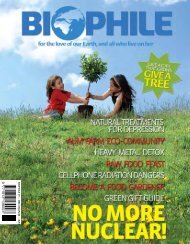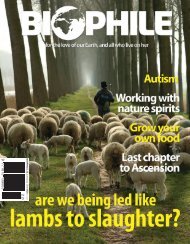BIOPHILE 16 â JUNE/JULY 2007 R25 - Biophile Magazine
BIOPHILE 16 â JUNE/JULY 2007 R25 - Biophile Magazine
BIOPHILE 16 â JUNE/JULY 2007 R25 - Biophile Magazine
- No tags were found...
You also want an ePaper? Increase the reach of your titles
YUMPU automatically turns print PDFs into web optimized ePapers that Google loves.
Food from treesOur indigenous trees are a good sourceof food; they’re both beautiful, andbountiful.Wild fruits have an exceptionally highvitamin C content – partly what makesthem so acid – and sometimes a highprotein, fat, carbohydrate or mineralcontent.Global warming and climatechange are topics that are repeatedlydiscussed in the media andamongst concerned citizens ofPlanet Earth.And so they should be. Yet too fewpeople seem sufficiently motivatedto make a lasting and positive impacton these disturbing trends by changingtheir lifestyles even a smidgen. Itdoesn’t have to be a drastic, life-alteringchange. It can be as simple and rewarding,as planting a tree, or two, or three?Trees benefit the ecosystems of theworld by providing habitats for manycreatures that play significant roles inmaintaining the balance of nature. Theyfertilise and look after the soils, absorbmassive quantities of carbon dioxide,release life-giving oxygen, and absorbthe rainfall and slowly release it backinto the atmosphere or into groundwater supplies. They provide the magic,medicine and poison that minister tothe mind and spirit of man; fuel, timber,shade and shelter and, not least ofall, food provide for the physical bodywhich is, perhaps, more important inthe minds of many people.Our indigenous trees are a sourceof all these things, but let’s take alook at trees as a potential source ofnourishment.Over hundreds of years the wild treesin this country have provided sustenance– the difference between hungerand plenty, life and death, for peopleand their livestock, and for the wild animalswhich they hunted and on whichthey fed. Today, with our so-calledsophisticated tastes, many of these treefoods are unappealing to the palate.I was intrigued recently to see thenumber of folk – young and old - climbingon neighbourhood walls, and hangingprecariously off the boughs of thetrees planted along the length of oneof the main roads in our seaside villagein Cape Town. I stopped to investigate.The centre of interest was the beautifulplum-coloured fruits of the waterberry– also known as Waterbessie (Afrikaans),umdoni (Xhosa, Zulu), montlho (NorthernSotho) and (more technically) Syzigiumcordatum – whichwere growing in profusionon these rathersplendid trees.I tasted the fruits,somewhat takenaback that I hadnever noticed thembefore, and waspleasantly surprisedat the sweetnessof the obviouslyripe ones, and thesour and tangy taste ofthose still to reach their prime.Syzigium cordatum – the waterberrytree – belongs to the familyMyrtaceae along withthe various guavas,pomegranates andAustralian gums.Most people are alsofamiliar with thecommon Eugeniaused as a hedgingplant. We’ve all usedallspice and clovesin the kitchen. Theseare the aromaticfruits and flowerbuds respectively ofother members of this same family, andwhich have great commercial value inAsia.The waterberry is an evergreen, waterlovingtree occurring fairly widely inSouth Africa and in a wide range of habitatsranging from forest margins, alongwater courses, in open bush and rockyoutcrops, and from sea level to altitudesof 1 600 metres. It reaches heights of 12to 18 metres, the larger specimens beingfound in swamp forests where theyhave been described as being ‘literallysupported on top of quagmires by thetremendous spread of their roots’.Waterberries are dense with round orspreading canopies and are often moreluxuriant at the coast where the air ismore humid, and water tables may behigher. In fact, it is believed that thepresence of these trees in the wild indicatesthe presence of ground water. Theblue-green leaves are thick and leathery,well able to tolerate the gale-forcewinds in the South-Western Cape andnew foliage is bright red which addsto the aesthetic appeal of the tree. Inthe wild, browsing animals such as theKudu eat the leaves and there are certainlybirds such as the Crowned Hornbillwhich indirectly benefit by feedingoff the hairy caterpillars of moths andbutterflies that sometimes infest it oc-Syzigium cordatumca-sionally.In early spring and summer theclusters of sturdy buds at the ends ofthe branches burst into creamy-whiteor pink flowers which drop their petalsvery quickly leaving little puffs ofstamens. The flowers have a delicatescent, produce large amounts of nectarand provide a good food source for beesand other insects. In late summer andautumn, the fleshy, deep pink to purpleberries ripen, each one with one pipand these provide food for humans anda variety of animals including monkeys,birds, tortoises and mice.This tree is perhaps one of themost useful in our arboreal anthology:• It provides nesting sites and habitatsfor a variety of wild life.• Its bark provides a reddish-brownor orange dye, is used as an emetic andto treat stomach complaints and diarrhoea.Powdered bark is also used as afish poison.• The leaves and roots are used forSoil for Life runs monthlyworkshops in Cape Town on allaspects of organic gardening. Checkour website (www.soilforlife.co.za)for details of these workshops. Bookearly to avoid disappointment!<strong>Biophile</strong> Issue <strong>16</strong>61
















